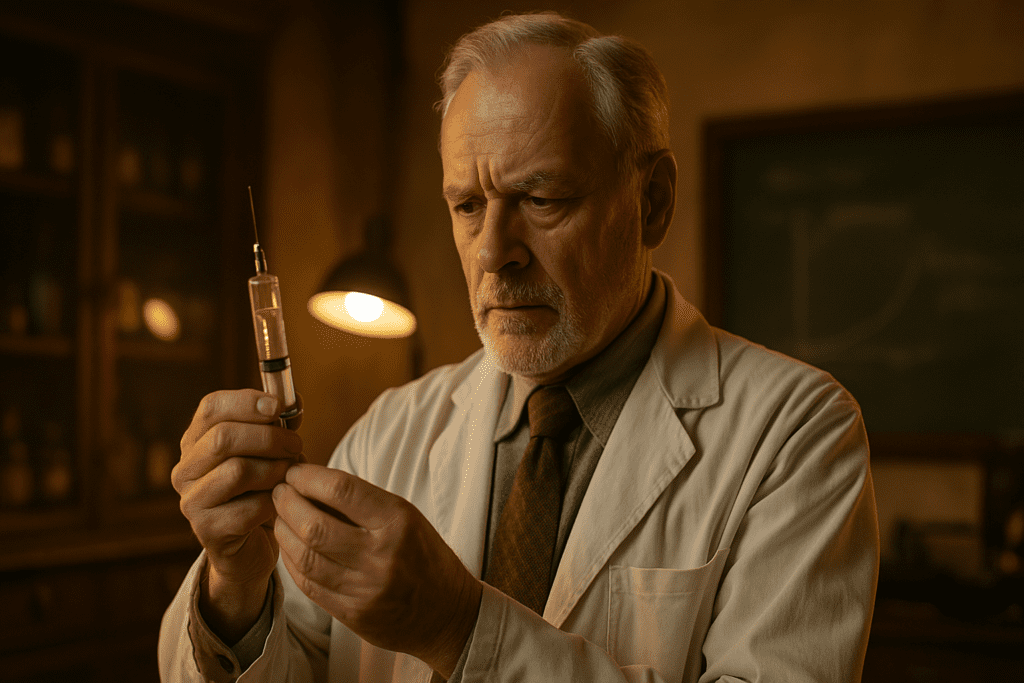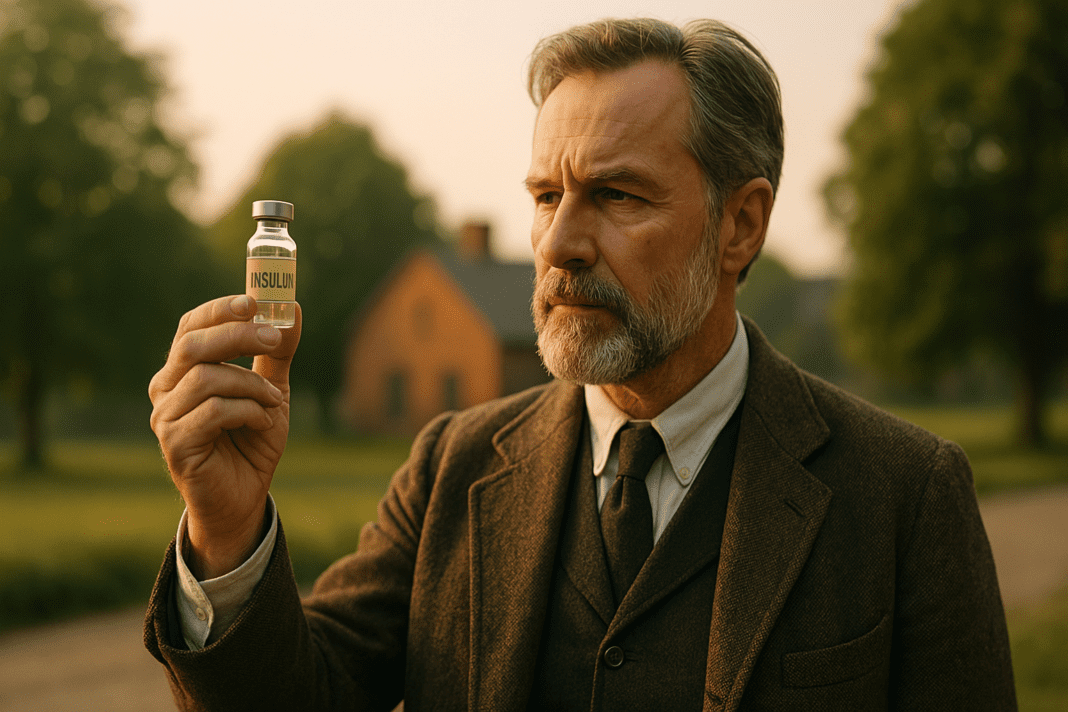Introduction: Unveiling One of Medicine’s Greatest Breakthroughs
Few discoveries in the history of medicine have had as profound and lasting an impact as the development of insulin. Today, insulin therapy stands as a cornerstone of diabetes treatment, but the story behind its discovery is as remarkable as the substance itself. For millions of individuals around the world, insulin represents not just a medication but a lifeline. Understanding when insulin was invented, where insulin came from, and who made insulin offers deep insight into a transformative moment in medical science. The insulin discovery is more than a historical milestone; it is a narrative of scientific perseverance, cross-continental collaboration, and ethical complexity. As we explore when insulin was first used and the evolution of its clinical application, we uncover the delicate intersection of laboratory innovation and human need that continues to shape diabetes care today.
You may also like: Breakthroughs in Current Diabetes Research: What the Latest Studies Reveal About Treatment and Prevention
Before Insulin: The Grim Outlook for Diabetes Patients
Prior to the invention of insulin, a diagnosis of diabetes—particularly type 1 diabetes—was effectively a death sentence. In the early 20th century, diabetes management consisted primarily of starvation diets aimed at prolonging life by minimizing glucose intake. While such regimens could delay fatal complications, they offered no real solution and often left patients emaciated and weak. Physicians and patients alike were desperate for an alternative, one that could go beyond symptom management and address the underlying metabolic dysfunction. This context sets the stage for one of the most groundbreaking moments in medical research: the insulin discovery. Understanding where insulin was discovered and how it moved from the realm of theory to lifesaving therapy is essential to appreciating the full magnitude of this medical triumph.

Laying the Groundwork: The Early Search for a Pancreatic Solution
The road to insulin’s creation began with a series of observations linking the pancreas to glucose metabolism. As early as the 19th century, scientists noted that removing the pancreas from dogs led to symptoms similar to diabetes in humans. These findings suggested that the pancreas produced a substance essential for regulating blood sugar. Although the term “insulin” had not yet been coined, the race was on to identify and isolate this mysterious compound. German physiologist Oskar Minkowski and his colleague Josef von Mering were among the first to demonstrate the pancreas’s crucial role in glucose regulation in 1889. However, it would take several more decades before insulin was developed into a usable treatment. Each failed attempt to extract and purify this elusive hormone added to the growing body of knowledge that would eventually yield success.
Who Is the Inventor of Insulin? A Collaborative Triumph
The question of who is the inventor of insulin does not have a simple answer. While Canadian scientist Frederick Banting is often credited with the breakthrough, the insulin discovery was a collaborative effort. In 1921, Banting partnered with Charles Best, a medical student, under the guidance of John Macleod at the University of Toronto. Biochemist James Collip later joined the team to assist with refining the extract into a form safe for human use. When asked, “Who made insulin?” the most accurate answer recognizes this team of researchers who contributed their unique expertise to a singular goal. Their combined efforts transformed theoretical speculation into a practical, scalable treatment. Understanding who the insulin creator truly was requires acknowledging this multi-faceted partnership.
When Was Insulin Discovered and Where Did It Come From?
Insulin was discovered in 1921 in a laboratory at the University of Toronto. When examining the timeline of medical advancements, the question of when insulin was discovered is not merely a matter of dates but of scientific context. The extract initially tested on dogs showed promise, but it was the first successful human trial in January 1922 that marked the true turning point. Leonard Thompson, a 14-year-old boy with type 1 diabetes, became the first person to receive insulin injections. His rapid and dramatic improvement provided definitive proof of the hormone’s efficacy. For those wondering where insulin came from in its original form, it was extracted from the pancreases of cows and pigs—an approach that would remain standard until synthetic human insulin was developed decades later.
Insulin’s Early Clinical Use: From Breakthrough to Standard Therapy
When was insulin first used to treat diabetes in what year? The answer—1922—represents a seismic shift in medical history. That year, insulin was first used on Leonard Thompson, but soon thereafter, it was administered to a broader group of patients with similarly life-saving results. Within months, insulin production began to scale, with pharmaceutical companies such as Eli Lilly partnering with researchers to make the drug widely available. This rapid translation from laboratory research to clinical application was unprecedented. When asking “what year was insulin invented,” it is essential to view 1921 as the year of discovery and 1922 as the year insulin first came out as a therapeutic tool. The process of moving from theory to therapy was unusually swift, driven by the urgent need and the clear-cut results of initial clinical trials.
The Ethical Implications of the Insulin Patent
One of the most remarkable aspects of insulin’s history is the ethical stance taken by its discoverers. Frederick Banting and his colleagues sold the patent for insulin to the University of Toronto for just one dollar, asserting that it belonged to humanity rather than to any single individual or company. This decision has become a landmark example of ethical medical innovation. Although the commercialization of insulin would eventually lead to controversy over pricing and access, the original intention was noble and humanitarian. This ethical legacy continues to shape debates about intellectual property in medicine, especially concerning life-saving drugs. In a world increasingly defined by pharmaceutical monopolies, the story of how insulin was created and shared offers a counter-narrative of altruism and public good.

The Evolution of Insulin: From Animal Extracts to Synthetic Biology
While insulin was first derived from animal pancreases, this method had limitations. The production process was labor-intensive, and the insulin could cause allergic reactions in some patients. In the 1980s, biotechnology revolutionized insulin therapy with the introduction of recombinant DNA techniques. This allowed for the creation of synthetic human insulin that was molecularly identical to what the body produces. Not only did this improve the safety and efficacy of the treatment, but it also answered long-standing questions about how insulin could be standardized for global use. Today, analog insulins—genetically engineered to act more quickly or slowly than natural insulin—offer even more precise control of blood glucose. This ongoing evolution of insulin illustrates how a discovery made over a century ago continues to inspire scientific innovation.
Public Health Impact: Transforming the Outlook for Diabetes Worldwide
Since insulin was first used to treat diabetes, the global outlook for individuals with the disease has changed dramatically. Once a uniformly fatal condition, type 1 diabetes can now be managed with a combination of insulin therapy, glucose monitoring, and lifestyle modifications. Type 2 diabetes, although more complex, also benefits from insulin in advanced cases. The ripple effect of insulin’s availability extends beyond individual patients to public health systems worldwide. Its discovery catalyzed the development of endocrinology as a medical specialty and transformed our understanding of metabolic diseases. When people ask when insulin was created, they are often also asking when hope was introduced into the management of diabetes. The year 1921, therefore, marks not just a scientific breakthrough but a turning point in the history of chronic disease care.
Continued Challenges: Equity, Access, and Affordability
Despite insulin’s enormous therapeutic value, access to it remains uneven globally. In many low- and middle-income countries, insulin is still prohibitively expensive or inconsistently available. This disparity has prompted international health organizations to campaign for broader access and affordability. While insulin was developed with altruistic intent, the modern pharmaceutical landscape has introduced barriers that contradict its original ethos. Understanding the history of insulin provides critical context for these ongoing debates. It also underscores the importance of policy decisions that align with public health rather than profit. Questions such as “when did insulin come out?” and “who made insulin?” are not just historical—they’re deeply relevant to contemporary discussions about healthcare equity.
Insulin Research Today: The Frontier of Metabolic Medicine
Current research continues to build on the legacy of the insulin discovery. Scientists are now exploring closed-loop insulin delivery systems, often called artificial pancreas devices, which automatically regulate insulin based on continuous glucose monitoring. Efforts are also underway to develop oral insulin formulations, potentially eliminating the need for injections altogether. Gene therapy and beta-cell regeneration techniques aim to restore the body’s ability to produce insulin endogenously, offering the tantalizing possibility of a cure for type 1 diabetes. These advances are part of a broader narrative that began when insulin was first invented and continues to evolve. The spirit of inquiry and innovation that led to the insulin creator’s original breakthrough remains alive in modern laboratories around the world.
Cultural and Social Legacy: Insulin as a Symbol of Scientific Progress
Beyond its medical implications, insulin occupies a unique place in the cultural imagination. Its discovery is often taught in schools as a shining example of scientific ingenuity serving the greater good. Museums, documentaries, and academic conferences continue to commemorate the anniversary of insulin’s discovery, reminding us of its enduring significance. The insulin creator and his colleagues are remembered not only for what they did but for how they did it—with integrity, collaboration, and a profound sense of responsibility. Understanding when insulin was first used and how it changed lives provides more than just historical knowledge; it offers inspiration for future generations of scientists and healthcare providers.

Frequently Asked Questions: The Insulin Discovery and Its Legacy
1. How did the insulin discovery influence modern pharmaceutical development?
The insulin discovery in the early 1920s not only revolutionized diabetes care but also laid the groundwork for the biopharmaceutical industry. When insulin was invented, it became one of the first examples of a biologic medication that could be mass-produced, stored, and distributed on a global scale. This prompted pharmaceutical companies to invest in hormone research, ultimately influencing the creation of therapies for growth hormone deficiencies, thyroid disorders, and more. Furthermore, insulin development catalyzed the concept of university-industry partnerships, as seen with the collaboration between the University of Toronto and Eli Lilly. The path forged when insulin was created has since become a model for how academic discoveries can transition into life-saving drugs through responsible commercialization.
2. What lesser-known ethical debates arose after insulin was first used?
While the public often celebrates the altruism of the insulin creators for selling the patent for $1, lesser-known ethical debates emerged concerning access and pricing. When insulin was first used in 1922, it was envisioned as universally accessible. However, within decades, rising production costs and limited patent protections led to varying prices globally, creating accessibility challenges, especially in low-income regions. The issue raised questions about how a life-saving medication developed in the public interest could later become unaffordable for many. These dilemmas persist today, forcing modern health systems to reflect on the original intent of those who made insulin and how to preserve equitable access in an era of pharmaceutical capitalism.
3. Where was insulin discovered, and how did location influence its success?
Insulin was discovered at the University of Toronto, a location that played a crucial role in its rapid clinical implementation. The institution’s existing infrastructure, including its medical school and biochemistry department, enabled a multidisciplinary approach that was essential for refining and scaling the hormone. The geographic location also facilitated swift collaboration with nearby pharmaceutical partners, such as Eli Lilly in Indiana. This proximity allowed for faster production and distribution once insulin was developed and proved successful in early trials. In a broader sense, where insulin was discovered highlights the importance of academic ecosystems that encourage open research, interdepartmental synergy, and public-private cooperation.
4. What technological advancements were inspired by the year insulin was invented?
The year insulin was invented, 1921, marked more than a medical breakthrough; it symbolized the dawn of translational medicine. The urgency and clarity of purpose behind insulin’s rapid development inspired researchers to create standardized methods of extraction, purification, and injection, which in turn led to advances in lab equipment and sterile manufacturing techniques. Innovations such as chromatography and enzymatic assays emerged as a direct response to the need for better insulin purity and measurement. These tools have since become foundational across multiple fields, including oncology and endocrinology. Thus, the legacy of what year insulin was invented extends far beyond diabetes and into the wider realm of precision medicine.
5. How did public perception of diabetes change after insulin was first used to treat it?
Before insulin was first used to treat diabetes in 1922, the disease was often viewed with hopelessness, associated with a slow and inevitable decline. The insulin discovery dramatically altered public perception, transforming diabetes from a fatal diagnosis to a manageable chronic condition. Families, communities, and medical professionals began to see the potential for long-term quality of life. Campaigns and education efforts followed, encouraging earlier diagnosis and lifestyle adjustments alongside insulin therapy. The dramatic impact when insulin came out shifted both clinical and societal narratives, making it a turning point in the social history of chronic illness.
6. Who is the inventor of insulin, and why is the answer complex?
The question of who is the inventor of insulin is often simplified, but the real story involves several contributors. While Frederick Banting is most commonly credited due to his initial idea to isolate pancreatic extracts, Charles Best, John Macleod, and James Collip also played indispensable roles. Best aided in the lab work, Macleod provided essential academic and logistical support, and Collip refined the extract for safe human use. In 1923, the Nobel Prize was awarded to Banting and Macleod, who then shared their honors with Best and Collip respectively—a rare move that reflected the collaborative nature of their work. Understanding who made insulin requires appreciating the nuanced interplay of experimentation, mentorship, and scientific synergy.
7. How did the original insulin creator influence future research ethics?
The ethical framework established by the original insulin creator team had a ripple effect on the norms of biomedical research. Their decision to relinquish the insulin patent for $1 emphasized that life-saving treatments should prioritize human welfare over profit. This act became a moral benchmark often cited in debates about intellectual property, access to essential medicines, and pharmaceutical responsibility. It also influenced the development of research funding policies, encouraging public investment in treatments for neglected diseases. The values established when insulin was created remain deeply embedded in the ethos of modern clinical research, especially in government-funded initiatives.
8. What role did global collaboration play after insulin was discovered?
When insulin was discovered, its significance was quickly recognized beyond North America, leading to international collaboration on unprecedented levels. European scientists adapted the Toronto team’s protocols to local needs, while researchers in Asia and South America worked on regional production techniques. By the late 1920s, insulin was being manufactured in multiple countries, each adjusting formulas based on available animal sources and technology. These efforts fostered an early form of globalized medicine, demonstrating how scientific knowledge can transcend borders when urgency demands it. The wide reach of insulin development after 1921 illustrates how a shared health crisis can catalyze international scientific unity.
9. What long-term innovations followed from the year insulin was developed?
Since the year insulin was developed, several long-term innovations have emerged in both medicine and technology. The challenge of maintaining consistent insulin doses led to the development of time-release formulations and analog insulins, which provide more precise glucose control. Advances in syringe design and, later, insulin pens and pumps, were driven by patient demand for convenience and accuracy. Additionally, digital glucose monitoring and mobile app integration now help tailor insulin therapy to individual lifestyles. These innovations, sparked initially by the insulin creator’s work in 1921, continue to evolve with input from engineering, informatics, and user-centered design.
10. How does understanding the history of insulin help us prepare for future challenges in diabetes care?
Studying the history of insulin provides crucial insights into how scientific breakthroughs are translated into public health strategies. The rapid deployment of insulin after its invention showcased the importance of adaptable infrastructure, clinical testing, and equitable policy-making. These lessons are especially relevant today, as emerging therapies like gene editing and immunomodulation are explored for diabetes. Moreover, the ethical debates that began when insulin was first used remain central to modern discussions about cost, access, and innovation. As we confront rising rates of type 2 diabetes and persistent disparities in care, the narrative of when insulin was invented reminds us that progress in healthcare is not just about technology—it’s about commitment to human dignity.
Conclusion: Revisiting the Insulin Discovery and Its Enduring Relevance
The question of when insulin was invented may seem like a straightforward inquiry, but its answer reveals a tapestry of scientific achievement, ethical integrity, and transformative public health impact. From its discovery in 1921 to its first clinical use in 1922, insulin has altered the course of countless lives and reshaped our understanding of chronic disease management. Knowing when insulin was first used to treat diabetes, who made insulin, and where insulin came from provides more than just historical context—it illuminates a pathway of progress that continues to unfold. The story of insulin is not merely about a molecule; it is about the relentless pursuit of solutions to human suffering. As we face new healthcare challenges in the 21st century, the legacy of insulin reminds us what is possible when science, compassion, and determination converge. Whether you’re asking what year was insulin invented or exploring the history of insulin in medical literature, the answer points to a milestone that continues to define the frontiers of modern medicine.
diabetes treatment breakthroughs, history of diabetes care, hormone therapy for diabetes, Frederick Banting contributions, evolution of diabetes management, medical research milestones, synthetic hormone development, biopharmaceutical innovations, global health discoveries, landmark medical inventions, insulin production methods, endocrinology history, 20th century medical advances, chronic disease management, lifesaving medical therapies, academic medical discoveries, ethical medical research, global access to medicine, diabetes medication development, transformative medical discoveries
Further Reading:
100 Years since the Discovery of Insulin, from Its Discovery to the Insulins of the Future
Disclaimer
The information contained in this article is provided for general informational purposes only and is not intended to serve as medical, legal, or professional advice. While MedNewsPedia strives to present accurate, up-to-date, and reliable content, no warranty or guarantee, expressed or implied, is made regarding the completeness, accuracy, or adequacy of the information provided. Readers are strongly advised to seek the guidance of a qualified healthcare provider or other relevant professionals before acting on any information contained in this article. MedNewsPedia, its authors, editors, and contributors expressly disclaim any liability for any damages, losses, or consequences arising directly or indirectly from the use, interpretation, or reliance on any information presented herein. The views and opinions expressed in this article are those of the author(s) and do not necessarily reflect the official policies or positions of MedNewsPedia.


